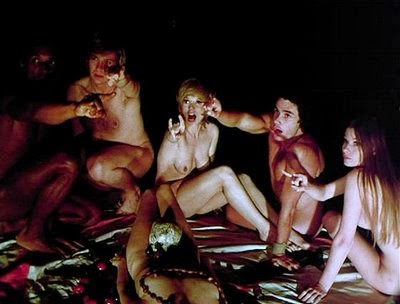
Carlos Puerto, 1978
Starring: Angel Aranda, Sandra Alberti, Mariana Karr, Jose Maria Guillen
Escalofrio (which means chills or shivers in Spanish) aka Satan’s Blood concerns a young married couple, Ana and Andres, who are out looking for an amusing weekend. They run into another couple, Bruno and Berta, who claim to be long lost old friends. They reluctantly agree to follow Bruno back to the couple’s house, though they don’t really recognize them. Unfortunately the house is a far drive out into the country. At the house the foursome immediately launch into a game with an elaborate Oujia board, which reveals some nasty secrets about both couples. Things take a turn for the menacing and confusing. Andres and Ana let themselves be bullied into staying the night and a number of events occur that make it unclear whether Bruno and Berta are benevolent Satan worshippers or have some other sinister purpose.
If you’ve been reading this blog - or happened to glance at the title - you can probably guess that I love Satanic cinema. Any piece of ‘70s trash that has a hopefully naked girl hopefully covered in blood and worshipping Satan will glue my ass to the couch for an hour or two. Of course, there are plenty of Satanic films that mention Satan a couple of times, but otherwise waste an hour or more hinting at Satanic, sexual, and violent pleasures that will never unfold on screen. I can promise you that Satan’s Blood is not one of those films. Sure, it has some slow and silly moments, but overall there is enough gore, Satan, sex, absurdity, and nudity to entertain any horror fan.
Plus there’s an orgy, plenty of death, and a twist ending. While those normally irritate me, this one really packs a punch. I didn’t find it particularly surprising, but it was a nice ending to a delightful and little seen cult film. There are some good performances, though chances are you haven’t heard of any of the actors unless you’re very well versed in Spanish cinema. Ángel Aranda is the most famous of the bunch and also appeared in Mario Bava’s Planet of the Vampires and Sergio Leone’s Colossus of Rhodes. Direction was split between Carlos Puerto, who also wrote the film, and Juan Piquer Simón. Puerto directed Spain’s most famous horror star, Paul Naschy, in The Sniper (1977). Simón was responsible for a number of cult films in the ‘80s and ‘90s, including The Pod People, Slugs, The Rift, and Cthulhu Mansion. Most importantly, he directed one of my favorite films of all time, Pieces.
Satan’s Blood is definitely recommended and is available on DVD from Mondo Macabro. There are some nice extras. There is an interesting, informative article about how the film fits into ‘70s Spanish cinema. In 1975 (post-Franco) a majority of the censorship in Spain disappeared and a rating known as “Clasificada S” was introduced. Oh yes, the ‘S’ is for sex. I had hoped it would be for Satan, but sex is almost as good. In general it refers to films like Satan’s Blood, which was one of the first to receive such a rating, that deal with sex, nudity, blood, gore, and/or the occult. All the good things in life, in other words. The other extras include an alternate opening, which is from the censored Spanish theatrical release. It is basically a lecture about the existence of evil and Satan, assumedly trying to justify the sex, violence, and Satanism about to follow. There are a variety of still galleries and a pretty cool trailer montage from Mondo Macabro. The best extra is a documentary, “The Devil’s Disciples,” where author and Church of Satan Reverend Gavin Baddeley gives a thorough run down of modern Satanism.


















